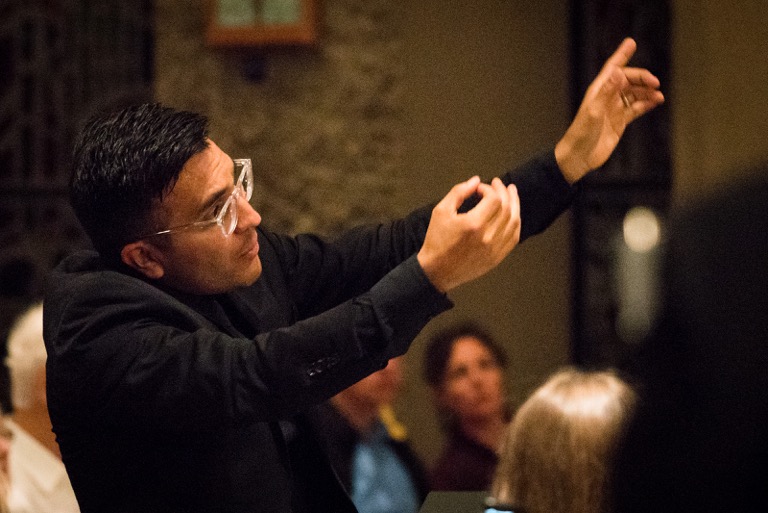Bach Collegium San Diego Offers a Rewarding Tribute to Christmas Music by Marc-Antoine Charpentier
Like many of northern Europe’s aspiring young composers in the mid-17th century, Marc-Antoine Charpentier traveled to Italy to experience opera first hand in the land where it began and flourished. Historians believe he studied in Rome with the influential Giacomo Carissimi, and the when Frenchman returned to Paris, he set about composing for the stage.
Success eluded him, however, until he turned his hand to writing sacred music. Then there was no stopping him—especially when the Jesuit order discovered the powerful emotional appeal of his sacred oratorios—and over his long career he composed some 600 works for the church.
On December 19, Artistic Director Ruben Valenzuela and his cohorts of the Bach Collegium San Diego presented a rewarding program devoted to Charpentier’s music at All Souls’ Episcopal Church in Point Loma. Given the season, Valenzuela chose Charpentier’s familiar Messe de Minuit pour Noël, H. 9, (Midnight Mass for Christmas) and his Christmas oratorio In Nativitatem Dominum Canticum, H. 416.Although this Midnight Mass for Christmas, a work based on the tunes of traditional French carols, is rather well-known in North America, hearing it performed by eight solo voices trained in Baroque performance practice with a period instrumental ensemble brought the work’s brilliance and drama into focus in a way that a performance by your typical parish choir and pick-up orchestra seldom reveals.
Valenzuela’s brightly paced opening Kyrie Eleison captured the flair of the noël on which it is based, aided by his singers’ adroit phrasing and crisp articulation. The suave dissonances of the Christe Eleison benefited from the vocal radiance of countertenor Daniel Moody and baritone Ben Karez in a flowing duet over simple basso continuo. The vigorous final Kyrie Eleison featured full chorus and orchestra with resonant oboes substituting for the recorders of the opening movement. Michael Sponseller offered stylish noël variations on the continuo organ following each Kyrie setting, as indicated in the score.
Charpentier’s vivid text painting suffused the Gloria of the Mass, opening with a hushed, ravishing “Et in terra pax” for the chorus followed by a glorious, dance-like “Laudamus te.” The two sopranos, Arwen Myers and Andrea Zomorodian, offered a flashy duet, “Quoniam tu soulus sanctus,” filled with spirited themes punctuated by clever echo effects from oboists Kathryn Montoya and Stephen Bard.
The buoyant instrumental Offertory also featured the oboes in a winning miniature concerto setting. Charpentier found consistently satisfying, inventive ways to portray the dense theological precepts of the Credo and Sanctus. Valenzuela and the Bach Collegium musicians boldly increased the dramatic tension of the Credo’s final section, “Et expecto resurrectionem mortuorum,” to provide a radiant conclusion “Et vitam venturi saeculi.”
Although Charpentier called his In Nativitatem Domini Canticum an oratorio, given its structure and length, we would likely call it a cantata. In fact, Charpentier’s work covers the same portion of the biblical Nativity story—the appearance of the angel host to the shepherds at work in the fields—related the second cantata of J. S. Bach’s later–and much longer– Christmas Oratorio.
The composer gives his chorus several roles: providing assurance of the promised Messiah, expounding the praise the angel choir, and rejoicing as the enlightened shepherds. Each of these roles the Bach Collegium choral ensemble portrayed with confidence and brio, as well as a richly balanced sonority. In the aria assigned to the angel proclaiming the birth of Jesus, tenor Corey Shotwell brought exuberance and vocal allure to his ornate announcement.
I was impressed by Charpentier’s deftly crafted, mood-setting instrumental interludes, which enriched the dramatic arc of his oratorio. His “Night” tone poem shimmered with quiet murmurs from the the stings alone, sustained by a gentle pizzicato bass line, and once that mood was established he woke the dozing shepherds with a vibrant, short orchestral reveille. His clever march music depicting the shepherds journey to Bethlehem, however, suggested a disciplined military cadence that sounded unlikely for a gaggle of rustics.
This In Nativitatem Dominum Canticum is one of half a dozen oratorios Charpentier wrote for the Christmas season, and if the others have the charm and craft of this oratorio, I say bring them on and leave those well-worn Messiah scores on the storage shelves.
Valenzuela’s program also included a Concert pour quatre parties de violes, H. 545, a six movement dance suite for strings that prefigures the string quartets of Haydn a century later.
This program by the Bach Collegium San Diego was presented on December 18, 2021, at the Sts. Constantine and Helen Greek Orthodox Church in Encinitas, and on December 19, 2021, at the All Souls’ Episcopal Church in San Diego. The San Diego performance was attended for this review.

Ken Herman, a classically trained pianist and organist, has covered music for the San Diego Union, the Los Angeles Times’ San Diego Edition, and for sandiego.com. He has won numerous awards, including first place for Live Performance and Opera Reviews in the 2017, the 2018, and the 2019 Excellence in Journalism Awards competition held by the San Diego Press Club. A Chicago native, he came to San Diego to pursue a graduate degree and stayed.Read more…


Ken Herman’s powers of observation, insights and historical perspective are much appreciated, as always. Having listened to this program both nights, the more intimate acoustic at All Souls’ Episcopal Church in San Diego is better suited to appreciating the clarity and compelling inner voices of these works by Charpentier, compared to the Greek Orthodox Church, notwithstanding the visual splendor of the latter. Being a viol aficionado, I’ve heard the Charpentier suite for viols with no accompaniment and with theorbo, but not with portative continuo organ as it was with BCSD. The organ, while adding substantial fullness and warmth, often overshadowed the interplay of the four viol voices that, for me, make the piece so rewarding. Cudos to the versatile musicianship of the four players, for three of whom the viol is not their main instrument.